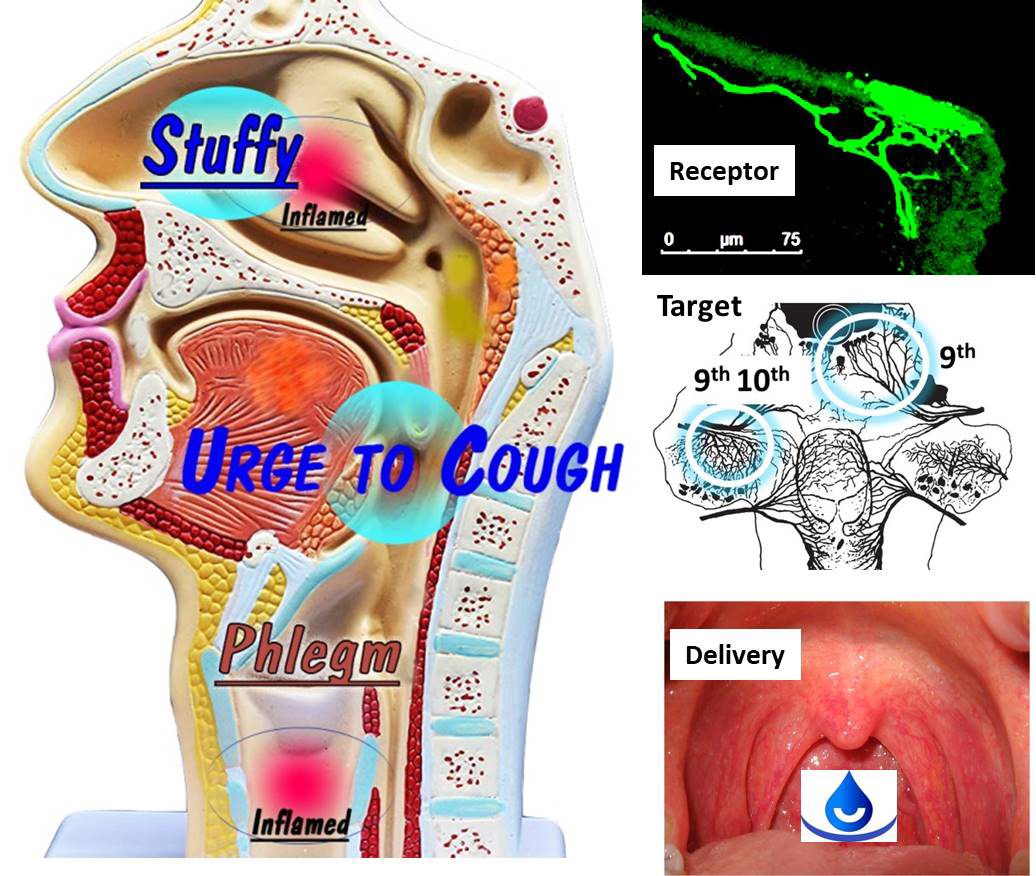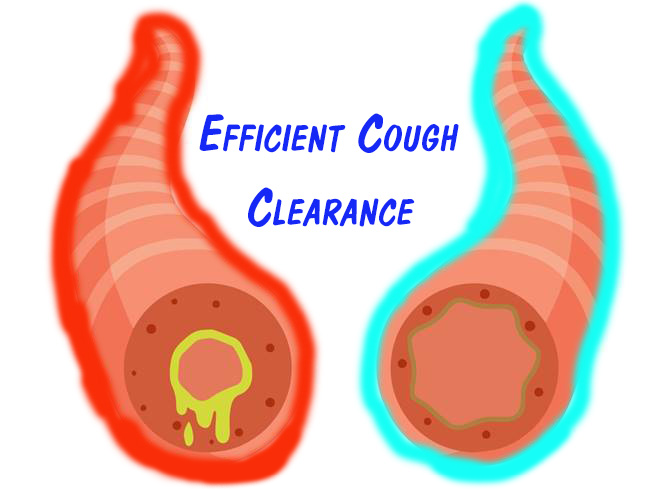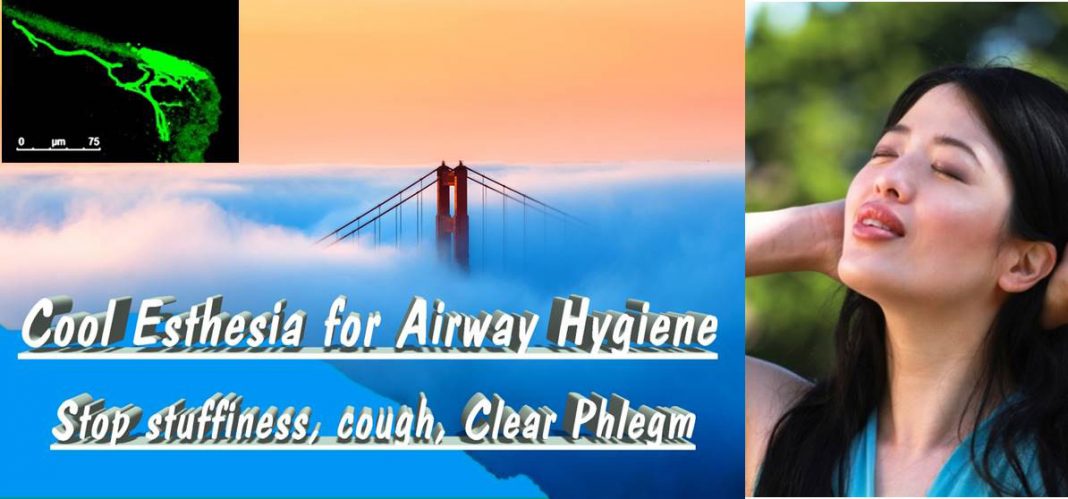Cryosim is a molecule that produces sensations of coolness but does not affect tissue temperatures. It can be delivered as a liquid to the surfaces of the nasal cavity and throat with an immediate cooling effect
We want our airways to feel cool and clean. In the nose, the result is cool breathing and the absence of stuffiness. For the throat, it is the absence of irritation and urge to cough. For inflamed airways, the goal is to get rid of phlegm or gunk. All of this can be done with Cryosims, molecules designed to produce cool esthesia. The cooling is immediate, so there is Instant Gratification (and adherence to use). Stopping stuffiness in rhinitis has value because 10-15% of the world’s population has rhinitis. Control of cough can treat upper respiratory tract infections. Symptomatic relief facilitates sleep, which has economic value in improved work productivity.
The airways begin at the nostrils and go past 23 generations of tubes to reach the air sacs or alveoli. These tubes must be kept clean, especially from the deleterious phlegm or gunk, which is a mixture of excess mucus, secretions, and debris of inflammation. An efficient way to remove gunk is by blowing the nose or coughing. The blower, like a category 5+ hurricane, generates airflow velocity of several hundred miles per hour. Cryosims give the patient the option of controlling the blower in the nose and in the throat to make gunk removal an efficient process.
Cryosims and airway disease
Airway disease is quite common. For individuals over 45 years, it is the third most common cause of death tied with accidents, after cancer and heart disease. Current drugs treat lower airway inflammation, secretions, or musculature. A Cryosim to enhance the clearance of phlegm may add to this arsenal of medications. In the nasal cavity, an aid to phlegm clearance in rhinitis may reduce risks for sinusitis. For the lower airways enhanced removal of gunk may slow the deterioration seen in chronic obstructive pulmonary disease. The goal of treatment is to make the blower an essential tool for airway hygiene.

The pharmacology and structural biology of cryosims
A cryosim produces sensations of coolness by acting on a transduction receptor called TRPM8, a member of the TRP family of cation channel proteins. The pharmacology and structural biology of cryosim on TRPM8 have been resolved by cryo-electron microscopy to ≤ 4 Ångstroms (Research Outreach vol. 131, 42-45, 2022; Yin et al. vol. 378, October 24, 2022 issue of “Science”). When temperature drops, TRPM8 pores open, and axonal depolarization sends signals to the brain from the receptive field. The TRPM8 nerve endings on mouse nasal mucosa can be seen in green (see Figure). A topical cryosim generates an immediate drug signal, so sensory relief is fast. The anatomic target sites, the TRPM8 receptive field on nerve endings, are on the 5th (trigeminal) nerve for cool breathing and on the 9th and 10th nerves in the oropharynx for control of the urge to cough (see Figure). Drug delivery is topical, by spray or liquid drops.
Cool esthesia of the airways may be the 5th dimension of pleasure, the first four being food and shelter, sex, inflating one’s ego, and making money. You miss cool breathing when you don’t have it. Stuffed-up breathing is the most bothersome complaint of a person with rhinitis. For the throat, an itchy cough or soreness is the most frequent reason for patients to seek medical help. Cryosim gel, drops, or nasal spray, gives cool breathing and reduces throat irritation.

The past and future of Cool Esthesia
The idea of cool esthesia to relieve upper airway discomfort is not new. Menthol has been around for over a hundred years to treat nasal stuffiness in vapor formulations and for cough in lozenges. However, menthol has inherent flaws of taste, irritancy, limited duration of action, and difficult delivery. In drug discovery, a prototype undergoes a slow metamorphosis. Witness the evolution of salicylic acid from willow bark to aspirin to ibuprofen and opium resin to morphine, then codeine, heroin, oxycodone, methadone, and fentanyl. For menthol, Wilkinson Sword (WS) scientists made 1200+ analogs ~40 years ago, but WS analogs are not used for airway disorders. The cryosims were created by Prof. Edward T. Wei who earlier identified and named the cooling molecule known as icilin. Cryosims (e.g., 1-diisopropylphosphorylnonane, CAS 1507344-37-7) are water-soluble and easy to deliver. They have a sufficient duration of action and evoke the full spectrum of cooling from cool, cold, frigid cold, to noxious cold.
“Cool Esthesia” with cryosims can treat nasal stuffiness and control the urge to cough.
The idea of using cool esthesia to blow out gunk and enhance airway hygiene is new. The expiratory muscles efficiently remove phlegm. Pulmonologists know that phlegm harms the lower airways. Irrigation of the upper airways with saline to help remove phlegm from the nasal passages is now common. Cool esthesia clears gunk with instant gratification. Current adherence to drugs for rhinitis and to broncho-inhalers for lower airway disease is about ~30%, so management is not ideal. The use of cool esthesia to guide airway hygiene offers a new strategy for treatment.

This work is licensed under Creative Commons Attribution-NonCommercial-NoDerivatives 4.0 International.


